#oil on aluminum panel
Explore tagged Tumblr posts
Text

Mary Jane Ansell, "Eye of the Storm", 2024, oil on aluminum panel. B. 1972, British Postwar & Contemporary artist.
#Mary Jane Ansell#eye of the storm#2024#oil on aluminum panel#british artist#oil painting#painting#art#white#shirt#fabrics#woman#portrait#ship#sea#light#clouds#green#grey#water#sky#ocean#waves#wind#seascape#storm#eye#realism#photorealism#hyper realism
40 notes
·
View notes
Text

Nick Farhi - Marla and Rhoda´s Place (yarn garage), 2020 - Oil, pastel, enamel spray on aluminum panel
559 notes
·
View notes
Text

Ruben Pang (Singaporean, b. 1990)
My Body Likes Sin, 2015-2016
oil, alkyd and retouching varnish on aluminum composite panel
781 notes
·
View notes
Text
Oil is Thicker Then Blood (Part 108)
People were beginning to pack, the launch scheduled in the next four days.
Truthfully, they had been. Bit by bit, trying to cram as much as they could into a single suitcase each… because that is how much the weight limit allowed. One small suitcase for every adult drone, tucked under their sleeping pods for the duration of the journey on Copper-9's only… and most uncomfortable, commercial space flight.
Honestly… Uzi didn't have a lot she wanted to take with her. Her laptop, yup, it would be the last thing packed away though as it was currently in use researching remedies and diagnosis for an extremely sick toddler with sudden and apparently vivid nightmares.
The parts to her railgun she'd never actually gotten fixed. She got busy and dead drone parts were an absolute biohazard now, so no power source, thankfully all the parts unassembled left plenty of room for everything else…
Which aside from some extra clothes… nothing else seemed all that important. Sure there were plenty of old sketchbooks or trinkets she could take, but… she wasn't attached to much of it.
And N was even worse. The only thing he packed aside from a spare set of clothes was a tiny unlabeled box that he told Uzi not to open until they touched down on Titanium-28. Which kinda made her want to snoop on what it was… but she restrained herself.
Or. More accurately. She was too busy with everything else to get the time to see what it was secretly.
Which left still. Plenty of room.
And so… all of Tera's toys were going to go with them. Even the stupid, red plastic lizard that now was half chewed into nothing. A bit like Guys hand.
Which filled it up a bit more, so… when it was time to leave, they would pack Bishops owl blanket.
Uzi stared at the finished creation that was “The Shuttle.”
Tera snuggled up in what was essentially a pouch next to her core, the sound and warmth seemingly the only thing keeping her calm enough to sleep and eat. She'd stick her head out sometimes, little purple eyelights peering out over the edge before they disappeared again.
She was… near silent now. Except for her cries in the middle of the night or soft, yet threating growls when anyone other then her mom, dad or little brother tried so much as even touch her.
Uzi walked through the big aluminum door that would seal them all in when the time came, after walking up the launch strut stairs, if there was one thing she didn't miss is the extra weight or exhaustion of growing a whole being…
But she was surprised to see a person already standing in the shuttle, walking slowly, looking at every panel, every pod, every device with… awe, maybe?
“Mom?”
Nori turned around with a shocked look on her face. “Uzi! What are you doing out here? Shouldn't you be inside with the little ones?”
Tera poked her head out and hissed. Uzi couldn't see it, but her right eyelight flickered yellow for a breif moment.
“Ah.” Nori chuckled as Uzi smiled warily. “Thought getting her some fresh air might help.” Uzi explained, stroking her hand down the large pouch Tera was in, when Nori stepped closer, Tera balled herself up as close as possible to her moms core and refused to move.
“I wanted to come see your handiwork. Khan went on and on about it. Had to see it for myself up close.” The older woman smiled. “You got your brains from me, clearly.”
Uzi found her heart swelling just at the thought of her mother's pride, though it fell a moment later.
“I-If you were alive… even just as a core thing or whatever. Like you said, why didn't you come back?”
Nori seemed to flinch, as if not expecting or not liking the question, she paused for a moment.
“I was… looking for something.” She replied after a breif period of silence.
“What was it?”
…
“A patch. It's supposed to make the solver easier to control. No… surprise takeovers or… instincts that get too loud.” She explained. “I knew you had it, same as me. I wanted to give you an easier go… but after the rot started creeping in. I ran out of time.”
Uzi sighed. “It would have been easier if you were there…”
Nori looked at her, sadly. “I'm sure it would have been… that's where we're most similar I think though, once we get our minds set to something. We see it through…”
She gestures to the ship around them. “Point. This.” And she smiles. “I never would have thought about using the busted up old pods as parts to make an escape shuttle. I didn't think there would be enough of us left to pull something this size off, being honest.”
“It wasn't easy… there was a lot of people that started off too scared to help… but uh… I did accidentally announce I was pregnant during the pitch so-”
Nori near threw her head back in a laugh. “HAH! And then if they said no they'd feel like monsters… nice.”
Tera didn't like the laugh. She shuffled in her pouch.
“Kid doesn't like me.” Nori pointed out.
“Ah… no… I can't figure out why… she's loved almost everyone else, and then she got sick!”
“Hm.” Nori hummed, sliding her hand over one of the pods she was standing next to. “I kinda chalk that up with me not having my anti-virus be updated in… ten or so years. That's probably my bad.”
“Maybe….” Uzi huffed. She was frustrated and worried and confused because nothing was quite adding up even though the answer felt like it was right in front of her face- Ugh.
“Chin up. You do the best with the knowledge that you have.” Nori shrugged.
Uzi blinked.
“What did you just say?”
“Hm? You do the best with the knowledge that you have?”
She blinked again.
“Did you hear N say that or something?”
Nori blinked as well, and took a beat to respond. “Oh! Yes I did! That's where I got it from. Figured it might be comforting to hear his little saying or- whatever.” She waved her hand as if waving off the interaction.
Well… that was weird.
“I should head back and help your father pack… he's trying to fit all his tools into one suitcase. And it's not going to happen.”
She walked off, though as she went past Uzi Tera went mental in her pouch, shuffling and hissing though it's muffled behind the cloth.
“Alright. Calm down… shhhh my little bat.” She stroked the pouch again, hearing a sound off of different chirps and chatters that took a second to register…
She furrowed her brow. Thinking for a moment before she dailed up the audible frequency of her audials.
Squeak! “Danger!”
Chi! “Wrong!”
Prrap! “Away!”
Each sound that Tera made suddenly shifted into a much more understandable word, since when that was even a thing she didn't know… but Bishop was born doing it, and Tera had been rather early… how long has she been missing words because she was tuned to listen for the same audible frequencies as a human?
Uzi blinked as she looked back in the direction her mother had went. But she was already back within the bunker…
Consumed with curiosity, and a growing sense of anxiety. She unfurled her wings and flew to the tip of the shuttle, pointed upwards, ready to go.
The black and red spiderwebbing rot was everywhere. There was a fence that went around the outer perimeter of the bunker, and it was the only thing separating them from it, like it was somehow holding it back.
V had said it was getting close. But she surely didn't mean…
Her eyes hollowed as she looked out further, between the buildings that were bring consumed and drug underneath the decaying crust there was a great, shambling mass.
Hundreds, thousands of dead drones come back to life, tumbling over each other, crawling, if they had to, in a near march to them.
Some of them were attached to each other, the black tendrils growing into each other like a runaway fungus and conjoining them, dragging one across the ground as the other two carried on in lockstep.
It quite literally took her breath away. There were so many, from every side. Every disposed of drone that ever existed on Copper-9 converging onto one single point.
Them.
Next ->
#murder drones#oil is thicker then blood#uzi doorman#serial designation n#nuzi#biscuitbites#tera doorman#n and uzi#lets start wrapping this up shall we?
58 notes
·
View notes
Text
Neon Adjuration - Start
The bike sputtered to death on a cliché middle of nowhere American road. It might have well been straight out of a movie set with the rows of corn, gold light, and nothing else around for miles.
Jason was less than impressed.
After nearly an hour of pushing his bike and with the idyllic light quickly fading he was even less impressed. It wasn’t as if he didn’t have options. His insurance came with roadside assistance (he thought), he could give in and call a sibling to steal the Batplane and come get him, or a corn field wasn’t the worst place he’d ever slept. He had options, just none of them were really appealing.
Recognizing that the feeling was stupid didn’t make calling for help feel any less like giving up.
The corn field had to have rodents. As he had pushed his bike, they had turned from carefully manicured rows into wild, unmanaged looking things. Jason had enough sharing a bed space with rodents as a street kid to want to do it again. Jason was probably about ten minutes away from giving in and calling Dick when he saw the glow.
It was neon salvation looming out of the oppressive darkness.
The cyan light spread the furthest, but Jason could also catch magenta from where the sign was peering around the edge of what must be the shop the sign was connected too. The cast of the cyan light made the corn feel otherworldly, and Jason pushed his bike slightly faster. More of the sign was revealed with each step, carefully crafted letter by carefully crafted letter.
Jason nearly sagged in relief. Not only was it finally, blessedly civilization, but it was a mechanics shop. ‘Fix-it Freddy’s’, the sign cheerfully proclaimed. It sat next to just the sort of building that looked like it might hold up to the claim. The base structure was probably from the late 40’s, that magical time of growth when the war and dust had both faded, but it had obviously been altered and changed and repainted hundreds of times. Just from the light of the neon and the one, lonely white flood light above the large roll up door Jason could see a myriad of colors. The current one seemed to be an already fading cyan to match the sign.
Praying that shop either had someone still working or cheap security and a lock he could jimmy, Jason leaned his bike against his tired leg and rang the bell between the roll up door and the man door. His finger was barely off the buzzer before the aluminum panels shuddered and groaned. Creaking with all of the years in it, the door rolled up.
Hanging onto the chain was, well, not exactly what Jason was expecting to find out in the corn fields. They were young, Jason’s or close enough. The black hair was wild, long in the middle and pushed around from a long day of working with engine grease and oil but shaved close on the sides. The way the neon light caught their eyes practically made them glow. Their smile was almost concernedly easy. “Can I help you?”
“Yeah,” Jason said and then had to clear his throat and try again. “Yeah. I guess you’re Freddy?”
They laughed, tossing their head back. Magenta light brushed along the length of their throat. “Nah, Freddy’s been dead for nearly thirty years, not that it would stop him from working. I’m Danny, this is my place now. Why don’t you roll your bike in and we’ll take a look at it, okay stranger?”
“Jason,” he said reflexively.
“Jason,” Danny repeated with that same easy smile.
--
AN: Aaaaaaand Moody Monday check! (Can I get all the days of the week? Let's see! 2 down, 5 to go... fingers already taped together.)
Masterpost I no longer tag, visit the masterpost to subscribe!
554 notes
·
View notes
Text

1958 Chevrolet Corvette
This 1958 Chevrolet Corvette underwent a pro-street-style metamorphosis between 2008 and 2011. It is endowed with a 383 cubic inch stroker V8 engine, harmonized with a TH350 three-speed automatic transmission, and a narrowed rear axle featuring a limited-slip differential. The rear suspension has been upgraded with a ladder-bar configuration, adjustable coilovers, and the addition of a lift-off hood. The body, painted a striking red with white coves, comes with a detachable hardtop. Inside, a roll cage has been installed along with a B&M Pro Stick shifter, a shift light, aftermarket gauges, and black Procar bucket seats. The enhancements also include dual Edelbrock carburetors, Hooker headers, side-exit exhaust pipes, 15” alloy wheels, and front disc brakes. Acquired by the current dealer in February 2024, this modified C1 Corvette is now part of the Coffee Walk Corvette Collection in Wylie, Texas, and is offered without reserve, complete with build records and a clean Pennsylvania title.
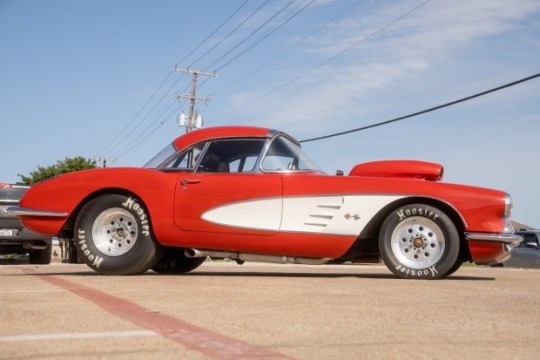
1958 Chevrolet Corvette
The fiberglass exterior is adorned in red with white coves and includes a removable hardtop and a lift-off hood with an integrated air scoop. A Stewart-Warner fuel-pressure gauge is mounted on the cowl, and the right-rear corner features a battery cutoff switch and external terminals. The gallery reveals cracks in the weatherstripping, pitted chrome, and paint imperfections.
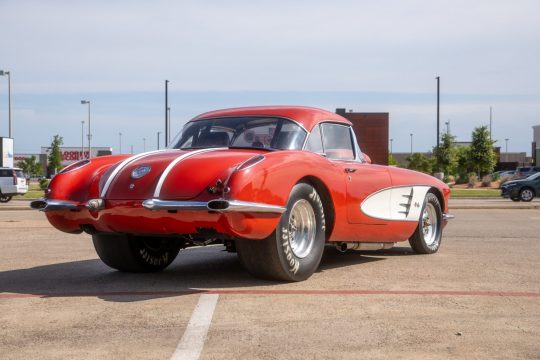
1958 Chevrolet Corvette
Polished 15” alloy wheels are shod with 25.0×5.0” front and 29.5×11.5” rear Hoosier drag tires, installed in April 2024. A crossmember supports the rear suspension, which has been modified with ladder bars, a diagonal link, and adjustable coilovers. The braking system includes front disc brakes and rear drums.
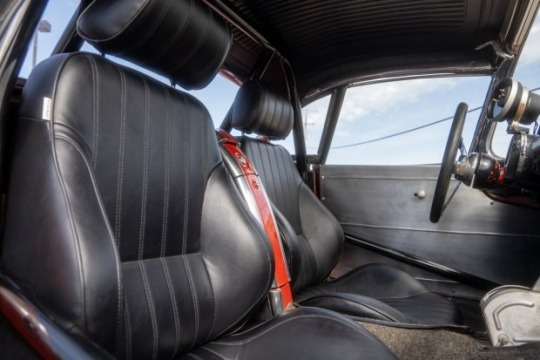
1958 Chevrolet Corvette
The interior is equipped with a roll cage and Procar high-back bucket seats in black. Enhancements include a B&M Pro Stick shifter, an MSD shift light, rocker-switch controls, and fabricated metal door panels. The gallery displays flaking paint and wear on interior surfaces.

1958 Chevrolet Corvette
The three-spoke steering wheel is positioned in front of a 160-mph speedometer and auxiliary gauges. An AutoMeter pedestal tachometer is mounted atop the non-functional factory tachometer. Additional gauges for coolant temperature and oil pressure are located in the center console. The mechanical odometer is inoperative, and the total mileage remains unknown.
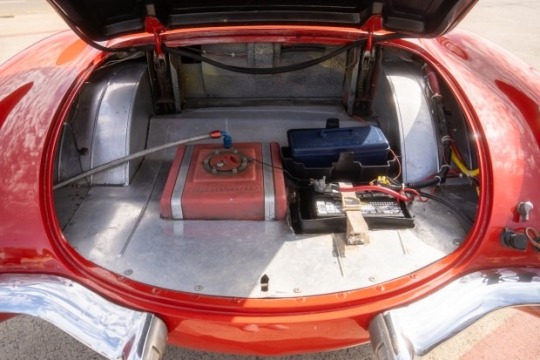
1958 Chevrolet Corvette
A Harwood plastic fuel cell is mounted in the trunk, which has been tubbed with fabricated aluminum panels to accommodate the rear wheels.

1958 Chevrolet Corvette
The 350ci V8 engine block, bored and stroked to 383ci, features four-bolt main bearings. The build includes forged pistons, ARP fasteners, a polished Edelbrock intake manifold, dual Edelbrock carburetors, an MSD ignition module, and Hooker long-tube headers that flow into side-exit exhaust pipes.
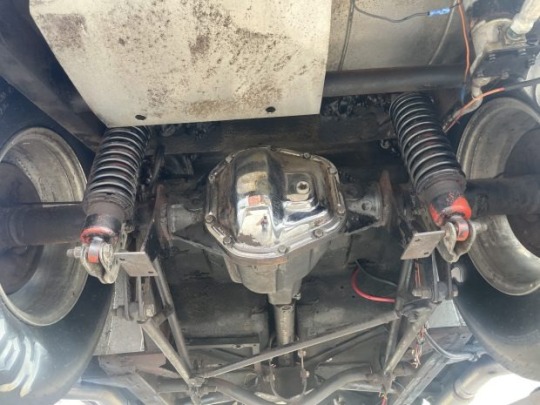
1958 Chevrolet Corvette
Power is transmitted to the rear wheels through a TH350 three-speed automatic transmission and a narrowed Dana 60 rear axle with a limited-slip differential.

1958 Chevrolet Corvette
155 notes
·
View notes
Text

“Policy of Truth”, 2021 by Alessandro Tomassetti (1970–present). Canadian figurative painter. oil on aluminum panel
234 notes
·
View notes
Photo

Vicky Wright — The Absent Face-Where Are You? (V) [oil and natural gesso with geological mica on linen over aluminum panel, 2017]
411 notes
·
View notes
Photo

Ruben Pang (Singaporean, b. 1990), Light the Caretaker, 2015. Oil, alkyd, acrylic and retouching varnish on aluminum composite panel, 127 x 86.5 cm
411 notes
·
View notes
Text

The SR 71 was at least 60 years ahead of its time.
The question was …is the SR 71 a product of its time? (Time frame would be late 1950s to 1966.)
Former U-2 technician Damien Leimback wrote; the following *In my opinion, this man is brilliant.*
He Disagrees with the question that the SR 71 was a product of its time.
I disagree because of the technologies that had to be invented or perfected in order for the plane to work that did not exist before the types (I include the A-12 here) introduction.
Here are some examples……
Using titanium in such massive amounts was unheard of in an aircraft; most of it is sourced from the Soviet Union through shell companies. New fabrication methods and new titanium alloys had to be created to build the plane.
Corrugated panels that expanded without changing shape were used in a novel way, as well as new types of glass for the windscreen and new ways of fusing it to the frame without the use of glue (that would melt under high temps) were used.
The fuel was routed through the leading edges of the wings to keep them cool and also to preheat the fuel for a better burn, novel approaches used for the first time on this plane.
The fuel itself was a custom blend and had a radioactive isotope added to it that allowed the ionization to scatter Radar waves in the high atmosphere. C-50 was used to secure the contract for the CIA. it was also called panther pi%s
Oils and lubricants had to be custom blended for the aircraft in order to function at the high and low temp extremes the plane would encounter.
The David Clark company built a pressure suit for the pilots, as the one the U-2 pilots wore was insufficient. The U-2 pilots later adopted the same suit.
The tires had aluminum mixed with latex in order to withstand the temps that would be encountered in the wheel wells during flight.
The J-58 engine was a hybrid of the turbo jet and ramjet, and MOST EFFICIENT at Mach 3.2, unheard of anywhere before or since.
And this is just a small sampling of the technologies that had to be invented or perfected in order for this plane to work. No one else was capable of flying anything like it in the 1960’s and its performance has yet to be matched today, almost 60 years later. If that's not ahead of its time, I don't know what is.
Posted by Linda Sheffield
@Habubrats71 via X
#sr 71 blackbird#aircraft#usaf#aviation#lockheed aviation#mach3+#habu#reconnaissance#cold war aircraft
42 notes
·
View notes
Text

Bryan Larsen, ‘Self Portrait from the Future,' 2021,
Oil on aluminum composite panel,
18x30 inches.
#art#surreal#fun#funnyshit#funny#funny pictures#painting#portraot#self portrait#bryan larsen#future#cosmic#space#celestial
15 notes
·
View notes
Photo

Amy Gibson, “In Retrospect”, 2023, oil on aluminum panel. American, b. 1976.
#amy gibson#in retrospect#2023#oil on aluminum panel#american artist#oil painting#painting#art#retrospect#aluminum#hat#woman#portrait#figurative art#contemporary art
21 notes
·
View notes
Text

Scott Kiche - Hidden World, 2019 - Oil on aluminum panel
55 notes
·
View notes
Text

Ruben Pang (Singaporean, b. 1990)
Fear So Long What Passes Quickly, 2015
oil, alkyd and retouching varnish on aluminum composite panel
348 notes
·
View notes
Text

'Study #2' by Alberto Ortega Oil on aluminum panel
48 notes
·
View notes
Text

Rebecca Munce (Canadian, b. 1991, lives and works in Montreal), Seedling, 2024. Oil on aluminum panel, 84 x 60 in. | 213.5 x 152.5 cm. (Source: McBride Contemporain, Montreal)
#Rebecca Munce#art#contemporary art#21st century art#Canadian art#Canadian artist#fantasy#magic#magical#spiritual#supernatural
7 notes
·
View notes